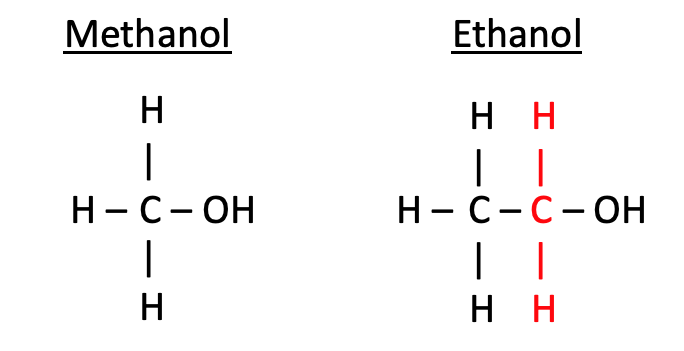Ethanol and Methanol
Ethanol and Methanol: In recent times intensive research has been carried out to find out alternative to fossil fuels with an aim of reducing dependency on petroleum. These fuels generate lower air pollutants compared to petroleum and a majority of them are more economically beneficial compared to fossils fuels. They are also renewable. The most common fuels that are used as alternative fuels are natural gas, propane, methanol, ethanol, and hydrogen.

Ethanol and Methanol- Similarities
Simply put Methanol and Ethanol are variants of alcohol. In fact Methanol (CH3OH) and ethanol (C2H5OH) are the simplest members of the primary alcohol family. They however have different properties and uses. In low quantities ethanol or methanol have been added to petrol. Ethanol and methanol can be manufactured from natural products or waste materials which is renewable, whereas gasoline fuel which is a non-renewable energy. An important feature is that methanol and ethanol can be used without requiring any significant changes in the structure of engines. As the molecules of both ethanol and methanol contain oxygen, it allows the engine to more completely combust the fuel, resulting in fewer emissions and thereby reducing the occurrence of environmental pollution. Moreover both ethanol and methanol are water soluble and biodegradable in the environment. The consequences of a spill of either would be much less than that of petroleum products.
Ethanol- Properties and Uses
Ethanol, an anhydrous ethyl alcohol can be produced from sugarcane, maize, wheat, etc which are having high starch content. In India, ethanol is mainly produced from sugarcane molasses by fermentation process. The Government of India decided to launch Ethanol Blended Petrol (EBP) Programme in January, 2003 for supply of 5% ethanol blended Petrol. At present, this programme has been extended to whole of India except Union Territories of Andaman Nicobar and Lakshadweep islands with effect from 01st April, 2019 wherein OMCs sell petrol blended with ethanol up to 10%. OMCs are advised to continue according priority of ethanol from 1) sugarcane juice/sugar/sugar syrup, 2) B heavy molasses 3) C heavy molasses and 4) Damaged Food grains/other sources, in that order.
Methanol- Properties and Uses
Methanol is a low carbon, hydrogen carrier fuel. It can be produced from high ash coal, agricultural residue, CO2 from thermal power plants and natural gas. Methanol burns efficiently in all internal combustion engines, produces negligible particulate matter and soot, almost nil SOX and NOX emissions (Near Zero Pollution). One of the reasons why Methanol has the potential to be an enduring solution to human energy needs is because the belched out C02 (greenhouse gas emission) both from using Methanol and while producing Methanol can be tapped back to produce Methanol. Thereby a seamless loop of CO2 sequestration cycle is created to perpetually burn fuels without polluting the environment at all. C02 from steel plants, Thermal Power plants, Cement Plants etc. can be tapped in large quantities to produce Methanol.
Ethanol and Methanol- Differences
- Both substances can be used as energy sources, but methanol currently serves mainly as a subject of research. Ethanol’s role is currently larger.
- Methanol is cheaper than ethanol.
- Methanol can also be made from a broader variety of biomass materal, as well as from coal and natural gas.
- Methanol is the safest motor fuel, because it is much less flammable than gasoline
- Ethanol is less chemically toxic than methanol
- Ethanol carries more energy per gallon. Ethanol contains about 75 percent of the energy of gasoline per gallon, compared to 67 percent for methanol.
- Both thus achieve fewer miles per gallon than gasoline, but about as many miles per dollar at current prices.
- Methanol is more corrosive than ethanol
- This can be dealt with by using appropriate materials in the automobile fuel system. A fuel system made acceptable for methanol use will also be fine for ethanol or pure gasoline.
- Government of India launched Ethanol Blended Petrol (EBP) Programme in January, 2003 for supply of 5% ethanol blended Petrol. At present the ethanol blending percentage of petrol is around 6.3%. However the methanol blending of petrol in India is almost negligible in India. NITI Aayog has drawn out a comprehensive plan to replace 20% of crude imports from Methanol alone. Adopting Methanol in this scale would bring down pollution in the country by more than 40% and not to forget the benefits from import substitution.
Read More: https://www.huffpost.com/entry/ethanol-vs-methanol_b_106380
Read Here for : Indian Nuclear Program
Read Here for: Indian Space Program